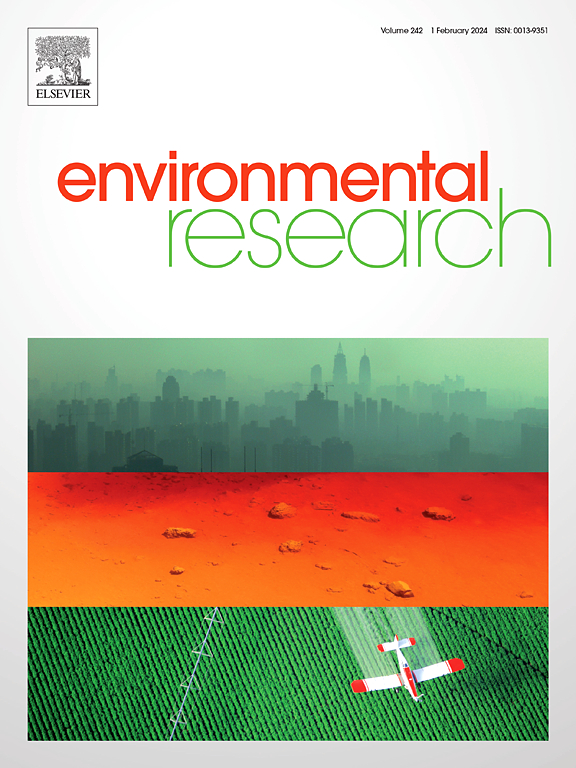Exploring multi-media geochemical relationships in the southeastern Amazonian basin: A way forward to define source and background levels of potentially toxic elements in lake sediments
IF 7.7
2区 环境科学与生态学
Q1 ENVIRONMENTAL SCIENCES
引用次数: 0
Abstract
Understanding geochemical source-sink relationships is an important aspect for developing background values of potentially toxic elements (PTEs) in a lake basin. This approach was studied in the Araguaia belt of Amazonia, Brazil. A total of 96 sediments (from 13 sediment core, low-altitude lateritic plateaus; LA2-LA14), 36 surface soils, and 19 catchment crusts/rocks were collected in 2022-2023 and chemical analysis of these samples was performed in the fine fraction (<177 μm) using XRF and ICP-MS. Results revealed that the PTEs concentration was significantly different (p < 0.05) between sediment, soil, and catchment rock, with more accentuated enrichment in rock followed by soils. The upper continental crust (UCC) normalization pattern shows that high enrichment of Fe, Ti, Ni, and Cr, and moderate enrichment of As, P and Cu in a few sediments, similar with catchment soils and crusts. Thus, the enrichment of PTEs in lake sediments is mainly controlled by dominant catchment lithology, whereby mafic and ultra-mafic bodies are the main source of Cr, Ni and Cu, whilst meta-mafic (Couto Magalhães Formation) rocks are a primary source of As. Principal component analysis (PCA) also supported a strong source-sink geochemical relationship. It identified the major bedrock geochemical signature Cr-Ni-Co as ‘mafic rocks’ and Al-Ti-Nb-Ga-Zr-Hf-U-Th as ‘resistant minerals’, and REE group, which were nearly similar between lake sediments, catchment soils, and crusts. Since the enrichment of PTEs is clarified by geogenic origin, these lake sediments are best suitable for establishing geochemical background (GB). This was calculated using a variety of methods, while the median ± 2 Median Absolute Deviation (mMAD) method was considered as most appropiate for this study. The new GB threshold values (estimated by mMAD) for As, Cu, Cr, Pb and Ni (most notably Cr and Ni) are significantly higher than those specified by the Brazilian CONAMA-L1 guidelines, as well as the regional GB values of Itacaiúnas River Watershed (IRW). Since these high values were already evidenced in catchment materials, the new GB threshold values should be considered as a more realistic reference value for anthropogenic risk assessment in the region. This is demonstrated by the results of the contamination factor (CF) of Cr and Ni in lake sediments, in which the CF values with respect to CONAMA limits and IRW GB values overestimated the contamination status. This finding made it clear that the site-specific GB values must be incorporated in the sediment quality guideline for improving contamination assessment and making any environmental decision of a given region.

探索亚马逊盆地东南部的多媒体地球化学关系:确定湖泊沉积物中潜在有毒元素的来源和背景水平的一种方法。
了解地球化学源库关系是确定湖盆潜在有毒元素(pte)背景值的重要方面。这种方法在巴西亚马逊河流域的阿拉瓜亚带进行了研究。利用XRF和ICP-MS技术,于2022年共采集了96份沉积物(LA1-LA13湖心13个)、36份表层土壤和19份集水区岩石,并对这些样品进行了细粒(< 177 μm)的化学分析。结果表明,沉积物、土壤和集水区岩石中PTEs浓度差异显著(p < 0.05),岩石中PTEs富集程度高于土壤;上陆壳(UCC)正态化模式显示,少量沉积物中Fe、Ti、Ni和Cr富集,As、P和Cu富集,与流域土壤和地壳相似。因此,湖泊沉积物中PTE的富集主要受优势流域岩性控制,其中基性和超基性体是Cr、Ni和Cu的主要来源,而元基性(Couto magalhes组)岩石是As的主要来源。主成分分析(PCA)也支持强烈的源汇地球化学关系。主要基岩地球化学特征Cr-Ni-Co为“基性岩”,Al-Ti-Nb-Ga-Zr-Hf-U-Th为“抗性矿物”,稀土元素组在湖泊沉积物和集水区土壤和岩石之间基本相似。由于PTE的富集被地质成因所澄清,这些湖泊沉积物最适合建立地球化学背景(GB)。Cu、Cr、Pb和Ni的新GB阈值(通过mMAD方法估计)大大高于巴西CONAMA指南规定的阈值,也高于IRW的区域GB值。由于这些高值已经在流域材料中得到了证明,因此新的GB阈值应被视为该地区环境风险评估的更现实的参考值。这在湖泊沉积物中pte(特别是Cr和Ni)的人为风险评估中得到了证明,当使用CONAMA指南计算时,显示出高到非常高的污染,但大多数表明相对于新GB的低污染。这一发现表明,特定地点的国标值必须纳入沉积物质量准则和监测方案,以便对特定区域进行污染评估和作出环境决策。
本文章由计算机程序翻译,如有差异,请以英文原文为准。
求助全文
约1分钟内获得全文
求助全文
来源期刊

Environmental Research
环境科学-公共卫生、环境卫生与职业卫生
CiteScore
12.60
自引率
8.40%
发文量
2480
审稿时长
4.7 months
期刊介绍:
The Environmental Research journal presents a broad range of interdisciplinary research, focused on addressing worldwide environmental concerns and featuring innovative findings. Our publication strives to explore relevant anthropogenic issues across various environmental sectors, showcasing practical applications in real-life settings.
 求助内容:
求助内容: 应助结果提醒方式:
应助结果提醒方式:


